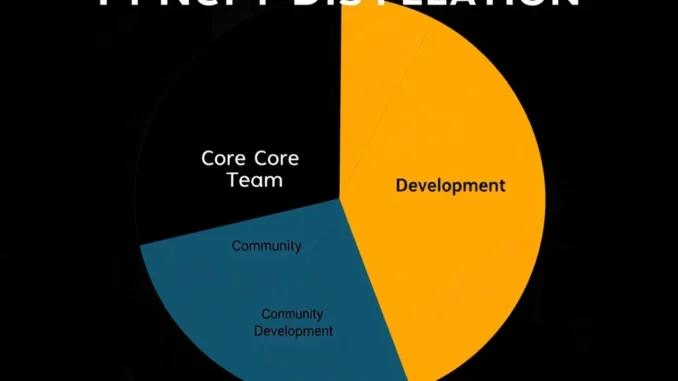
Is Pi Network, the cryptocurrency project that promised decentralization and mobile-first mining, truly living up to its claims? Recent revelations are casting a long shadow of doubt, suggesting a significant level of centralization that could be detrimental to its community and the project’s future. Let’s dive deep into the concerning data emerging about Pi Network’s token distribution and what it means for you, the potential user or investor.
Unveiling the Shocking Truth: Pi Network Centralization Concerns
According to a report by Watcher Guru, a staggering 82.8 billion PI tokens, out of the total 100 billion supply, are reportedly under the control of the Pi Network core team. This massive concentration of tokens raises serious questions about the project’s commitment to decentralization – a core tenet of blockchain and cryptocurrency technology.
Here’s a breakdown of the alarming token distribution:
- Core Team Wallets: A massive 62.8 billion PI tokens are allegedly held in just six wallets linked to the core team.
- Development Funds: An additional 20 billion PI tokens are distributed across 10,000 wallets, supposedly for development purposes.
This concentration leaves a relatively small portion of the total supply for the wider Pi Network community, directly contradicting the decentralized vision often touted by the project. But why is this level of Pi Network centralization such a big deal?
Why Does Pi Network’s Centralized Token Control Matter?
Decentralization is not just a buzzword in the crypto world; it’s a fundamental principle designed to ensure fairness, security, and transparency. When a significant majority of tokens are controlled by a single entity, or a small group, it introduces several critical risks:
- Erosion of Decentralization Narrative: Pi Network has built its appeal on the promise of a decentralized cryptocurrency accessible to everyone through mobile mining. However, with the core team holding the lion’s share of tokens, the project appears to be far from the decentralized ideal it promotes. This discrepancy can erode trust and lead to community disillusionment.
- Security Vulnerabilities: Centralized control points can become attractive targets for malicious actors. If the wallets holding these massive amounts of PI tokens were to be compromised, it could have catastrophic consequences for the entire network and its users. A truly decentralized crypto network distributes risk, making it far more resilient to attacks.
- Governance and Manipulation Risks: Such significant token holdings grant the core team immense power over the network’s future. They could potentially manipulate token prices, influence governance decisions, and control the direction of the project with minimal input from the broader community. This lack of distributed governance is a major red flag.
- Transparency Deficit: The lack of transparency surrounding the exact nature and purpose of these core team-controlled wallets further fuels skepticism. The community deserves clear and verifiable information about how these funds are being managed and used.
In essence, the reported PI token distribution structure resembles more of a centralized system than a decentralized cryptocurrency, raising serious ethical and practical concerns.
Comparing Pi Network to Truly Decentralized Blockchains
To truly understand the gravity of Pi Network’s centralization concerns, let’s compare it to established, genuinely decentralized blockchains like Bitcoin and Ethereum:
| Feature | Bitcoin | Ethereum | Pi Network (Reported) |
|---|---|---|---|
| Token Distribution | Widely distributed through mining and open market | Widely distributed through mining, ICO, and open market | Highly centralized, majority controlled by core team |
| Node Count | Tens of thousands globally | Thousands globally | Reportedly only 43 nodes |
| Active Validators | Thousands globally | Thousands globally | Reportedly only 3 active validators |
| Governance | Decentralized, community-driven consensus | Decentralized, community-driven consensus | Potentially centralized, core team dominant influence |
The stark contrast is evident. Bitcoin and Ethereum thrive on their vast, distributed networks, ensuring no single entity holds excessive power. Pi Network, in its current reported state, appears to deviate significantly from this decentralized model.
Community Frustration and Growing Skepticism
The revelations about token centralization are adding fuel to an already simmering pot of community frustration. Pioneers (Pi Network users) have been eagerly awaiting the open mainnet launch and the ability to migrate their mined PI tokens. However, delays and a lack of transparent communication have led to growing skepticism and concerns about the project’s legitimacy.
Key points of community frustration include:
- Token Migration Delays: The promised token migration to the mainnet has been repeatedly delayed, leaving users unable to access or utilize their mined PI.
- Governance Transparency: The community lacks clarity on governance processes and decision-making within the Pi Network ecosystem. The level of core team control over development and future direction remains opaque.
- Limited Network Activity: The reported low number of nodes and validators raises concerns about the network’s robustness and security, further contributing to the skepticism surrounding its decentralized nature.
Is Pi Network a Centralized Crypto Project? The Verdict is Still Out
While the data presented by Watcher Guru paints a concerning picture of Pi Network centralization, it’s crucial to remember that Pi Network has not yet launched its open mainnet. The project is still under development, and the final token distribution and governance mechanisms may evolve.
However, the current revelations warrant serious attention and scrutiny. For Pi Network to regain community trust and truly embrace decentralization, it needs to address these concerns head-on by:
- Providing Transparent Token Distribution Data: Offer verifiable proof and detailed explanations of token allocation and usage.
- Decentralizing Governance: Involve the community in governance decisions and establish clear, transparent processes.
- Expanding Network Decentralization: Increase the number of nodes and validators to enhance network security and resilience.
- Improving Communication: Maintain open and honest communication with the community regarding project development, timelines, and challenges.
Conclusion: Navigating the Future of Pi Network
The reports of significant centralization concerns within Pi Network serve as a stark reminder of the complexities and challenges in building truly decentralized cryptocurrency projects. While Pi Network’s vision of mobile-first crypto accessibility is compelling, the project must prioritize transparency, community engagement, and genuine decentralization to fulfill its promises and build a sustainable future. The crypto community will be watching closely to see how Pi Network responds to these critical concerns and whether it can pivot towards a more decentralized and trustworthy path.



